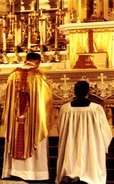Tridentine Mass begins with prayers at the foot of the altar. The priest recites the confeitor before ascending to the altar.
The Novus Ordo begins with the priest at the sedelia. The priest doesn't need to be at the altar because the Novus Ordo separates the "Liturgy of the Word" from the "Liturgy of the Eucharist" which diminshes the sacrificial nature of the Mass.
The Tridentine Mass has specific rubrics to signify the life of Christ on earth. The center of the altar represents Jerusalem, where Christ was sacrificed. The priest, facing east, ascends to the center of the altar and kisses it. He then moves to the south to read the introit, which is the first prayer that changes in the Mass. He moves south because Bethlehem, where Christ was born, is south of Jerusalem. The priest faces east when he reads the prayer. The reason the priest moves south for the first changeable prayer is because it signifies the beginning of the Mass of the day. It is a the "birth" of a new Mass, just as Christ was born in Bethlehem.
The priest returns to the center for the Kyrie and Gloria. Christ gave glory to the Father and poured out his mercy for us in Jerusalem, which is why the priest returns to the center.
The priest the reads the collect and epistle at the south end of the altar, again to signify the birth of Christ. The collect is just as it sounds, the priest offering the prayer for the people to the Father. The epistle is a reading from the Old or New Testament which compliments the Gospel reading of the day.
When the priest finishes the epistle, he returns to the center to say the munda cor, which he asks God to "purify his lips to proclaim the Gospel." This corresponds again to Christ's sacrifice on the cross in Jerusalem to purify us from our sins.
The priest then moves north to proclaim the Gospel. The reason for this is because Nazareth, where Jesus lived for the first 30 years of His life, is north of Jerusalem. Jesus began his mission to preach the Gospel from Nazareth, which is why the priest reads the Gospel at the north end of the altar.
All of this was eliminated from the Novus Ordo Mass. The priest doesn't even read the epistle readings. The Gospel is read from the ambo, as well as the epistle readings and the repsonsorial psalm. The priest hasn't even approached the altar at this point in the Novus Ordo Mass.
...the Novus Ordo is very Eucharistic centered. I do not doubt the validity and licitness of the consecration at the Novus Ordo Mass. The priest turns bread and wine into the body, blood, soul, and divinity of Our Lord and Savior Jesus Christ at every Novus Ordo Mass. However, to say that it is very Eucharistic centered is to miss the point of the liturgical revolution that was forced upon the Church in the name of the Second Vatican Council.
The Novus Ordo Mass was deliberately centered on the people. We all know the Novus Ordo can be said ad orientem. The fact that the priest doesn't even ascend the altar until after the Nicene Creed takes away from the sacrificial aspect of the Mass. The Novus Ordo also puts a focus on the "active" participation of the people, as if the people aren't actively participating by following the actions of the priest at the Tridentine Mass. Focusing on the people means taking away the focus on the Eucharist. The focus of the Mass can't be on the people and the Eucharist at the same time.
http://forums.catholic.com/showpost.php?p=1564495&postcount=15
http://forums.catholic.com/showpost.php?p=1564500&postcount=16
14 October 2006
Subscribe to:
Post Comments (Atom)



No comments:
Post a Comment